Freshmen have been excluded from these previews, as we'd like to wait and see what they have to offer on the NCAA level before we come to any long-term conclusions.
-Top 20 Prospects in the Big Ten
-Top 25 Prospects in the ACC
-Top 15 Prospects in the Big 12
-Top NBA Draft Prospects in the Pac-12, Part One (#1-5)
-Top NBA Draft Prospects in the Pac-12, Part Two (#6-10)
#11, Anthony Brown, 6'6, Sophomore, SG/SF, Stanford
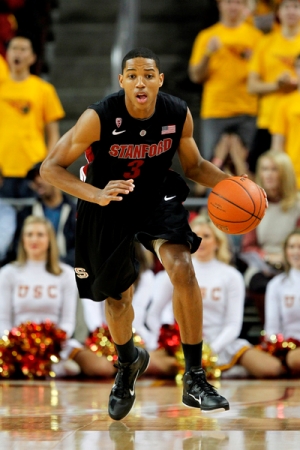
Derek Bodner
Anthony Brown worked his way into the Stanford starting lineup down the stretch, averaging 10.8 points and 4.7 rebounds per game over the struggling Cardinal's last twelve games of the season.
Brown has good size and long arms for his position. He has a slender frame and must fill out more to effectively defend some bigger wing players, but does look to have added some weight since graduating high school.
Offensively, Brown operates primarily as a set shooter at this stage in his development, with over 80% of his half-court shot attempts coming from jumpers. He has a high, effortless release and does a good job of getting his feet set on catch and shoot opportunities. The results are somewhat inconsistent, but with enough repetition it should be a staple of his game going forward.
Brown runs the floor well, and gets out in transition both as a finisher and trailing the play. He's neither a high flyer nor going to lead the break with regularity, but does a good job of filling the lanes and finishing.
The rest of his offensive game is a work in progress. Despite his length, he hasn't shown a post game, and his lack of bulk may still be a factor in this. He does very little off the bounce, and shot only 31.3% in a small sample size of isolation sets. He very rarely gets to the free throw line, as his 3.1 free throw attempts per 40 minutes pace adjusted is near the bottom of our list in terms of wing players. He has only an average first step and isn't a great leaper, although his long strides may help him gain separation if he becomes more comfortable creating off the dribble.
Brown does look comfortable shooting off the pick and roll. The amount of times he was placed in this situation was relatively small, but he could see his time in these sets increased as Stanford's staff looks to get him more involved in their half-court offense.
Defensively, Brown has average lateral mobility, but combats this with good length and good defensive technique. He needs to work on fighting through pick and rolls, as he tends to get cleared out too easily.
Brown has good size for his position and plays a fundamentally sound game. He was effective as a spot-up shooter down the stretch for Stanford, but with the loss of the Cardinals leading scorer in Jeremy Green and their point guard Jarrett Mann, there are going to be more opportunities for Brown to create on his own this year. Whether or not Brown can diversify his offensive game and create more, both for himself and for others, off the bounce will be key in both Stanford's success and his development as a prospect.
#12 C.J. Wilcox, 6'5, Sophomore, Shooting Guard, Washington
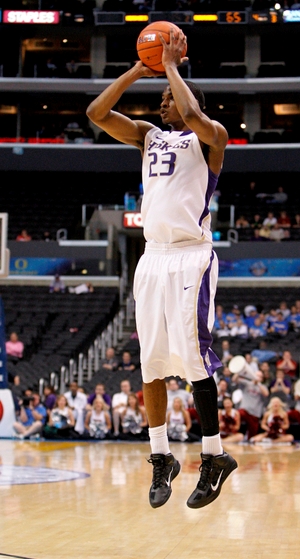
Matt Williams
Though Terrence Ross is the star of Lorenzo Romar's rising sophomore class, teammate C.J. Wilcox had a productive freshman year as well. Scoring 2 points per-40 minutes more than Ross on the year, Wilcox may not share Ross's upside at the next level, but proved to be a dangerous perimeter scoring threat.
Standing 6'5 with a decent wingspan and a frame that he would be well served to continue working on, Wilcox does not possess ideal physical tools for the NBA level. He isn't overly quick or explosive, and won't play above the rim unless he has considerable time and space. Considering that the young guard seems to have quite a bit of potential as a shooting specialist at the NBA level, his physical profile and athletic tools are right on par, if not better, than some players we've seen in a similar role in the past.
Wilcox's jump shot is easily his most intriguing asset from a NBA perspective. At the college level, defenders have to constantly be aware of where he is on the floor, whether it is in transition or a half court set. Whether he's running off a screen, trailing the break, or spotting up in the corner, Wilcox is devastatingly accurate whose quick and compact release is extremely reliable from beyond the arc when he's given time and space. According to Synergy Sports Technology, he knocked down 50% of his unguarded catch and shoot jump shots, and while his efficiency dipped below 30% when he had a hand in his face, he made teams pay when they didn't close him out.
Among the top players in our database in field goal attempts per-possession, Wilcox is never shy about pulling trigger off the catch. He proves capable of knocking down pull-ups with great consistency off of one or two dribbles when defenders are overly aggressive in closing him out, but will need to improve his accuracy when closely defended to improve his efficiency. He ranked in the top-15 in our database in points per-possession, but is still a ways off the type of efficiency that helped Jon Diebler get drafted.
The rest of Wilcox's arsenal offensively is fairly non-descript. He only attempted 11 shots at the rim last season, and seldom ventures inside the arc even when he's ahead of the play on the fast break. It isn't surprising that he doesn't get to the line at a high rate or create shots for others, but it will be worth keeping an eye on what he brings to the table as his playing time increases.
On the defensive end, Wilcox shows fairly average lateral quickness. He gets out of position at times and struggles against stronger players, but has a bit more to work with on the defensive end that many players we've seen in his mold in the past. If he can improve his body and his fundamentals, he should continue to improve on this end of the floor.
While Wilcox may not be the most exciting prospect in the college ranks, or even on his own team, he showed a valuable skill that with continued development could make him a draft prospect. With Terrence Ross and Tony Wroten breaking down defenses, Wilcox, at the minimum, is going to prevent defenders from collapsing on his talented teammates.
#13 Solomon Hill, 6-6, Small Forward, Junior, Arizona
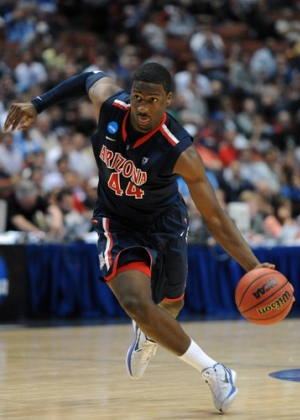
Joseph Treutlein
The 48th ranked high school senior by RSCI in 2009, Solomon Hill has had a relatively underwhelming first two seasons in Tucson, averaging just 8.0 points in 25.2 minutes per game as a sophomore. Hill is an extremely aggressive player with some intriguing physical abilities, and he should have some opportunities to fill the hole left by Derrick Williams this year if he isn't quickly overshadowed by Arizona's impressive recruiting class.
Standing 6-6 with a strong, thick frame and solid length, Hill is a bruising, attacking small forward of the Ron Artest variety, relying predominantly on his dribble-drive and short post game to contribute offensively. Hill shows very high levels of explosiveness, coordination, and mobility, though his thick build seems to hold him back in terms of leaping ability, where his athletic abilities are much less impressive in comparison.
Looking at Hill's offensive game, he does most of his damage attacking off the dribble, where he has a well-developed set of skills and a natural feel for breaking down a defense. He doesn't have typical advanced ball-handling skills, but he is excellent at utilizing spin moves, hop steps, up fakes, and other subtle change of direction to maneuver around his defender. He is extremely rangy in covering ground with his moves, showing a very good first step and excellent ability to create separation.
While Hill shows some excellent abilities in getting past his man and breaking down the defense, there are some concerns as he gets closer to the basket with the ball. Hill's leaping ability is not on par with his ability to get past his man, as he struggles to get up for power finishes at the basket, often relying on below-the-rim, contested lay-ups. He shows solid creativity in getting off shots, but his touch is lacking at times, especially when he has to resort to runners and floaters in the 5-10 foot range. Hill's attacking style also leads to problems with turnovers, as he's averaging 1.7 turnovers per game compared to just 5.6 field-goal attempts.
Looking at the rest of Hill's offensive game, he is attempting 1.3 three-point attempts per game and hit a respectable 35.4% of his attempts. His 78% free-throw shooting is also an encouraging sign, but he will need to put in the work to make this a more reliable and consistent aspect of his game. His shooting form is adequate enough, but further refinement and practice will be necessary to maximize his abilities.
Hill also does a good job utilizing his aggressiveness on the offensive glass, where his good second bounce and excellent strength lead to a lot of put-back opportunities. Cutting down some of his excess weight would allow him to leap higher for these finishes and do a better job converting them consistently.
Hill also shows some interesting potential with his passing game, where he's dishing out a solid 1.7 assists per game despite his low number of possessions. He actually was billed as somewhat of a point-forward later in his high school career, and this is something he could expand upon if he earns the opportunity, though now it is just an ancillary part of his skill set.
On the defensive end, Hill shows solid promise, having an aggressive and fundamental perimeter defensive stance, playing up into his man and constantly moving his feet and hands. He shows good focus and doesn't bite often for fakes, though his lateral quickness is just adequate, leading him to get beaten on occasion. In the post, Hill doesn't show a similar grasp of fundamentals as on the perimeter, showing very little use of good leverage and being beaten at a very high rate. With a better fundamental understanding of post defense, Hill could fare much better here given his physical attributes.
Looking forward, Hill has some intriguing skills and physical abilities, namely his explosive dribble-drive game, but developing into a more well-rounded prospect and losing some excess weight will likely be critical to his long-term prospects. NBA teams often look for both strong defense and off-the-ball offensive abilities from potential role players, and these are both areas where Hill could stand to improve.
#14 Richard Solomon, 6'10, Sophomore, Power Forward, California
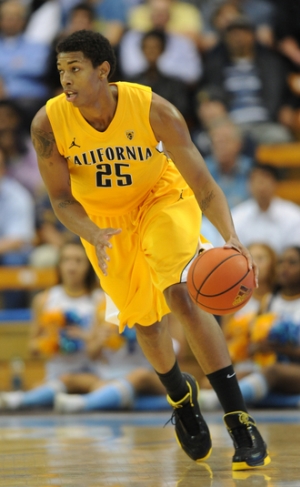
Matt Williams
Just missing out on making the USA U19 National Team this summer, Richard Solomon returns to Cal looking to build on a solid, albeit largely developmental, freshman season.
Standing 6'10 with a massive wingspan and an extremely lanky frame that he'll absolutely need to continue to add weight to down the road, Solomon is a good athlete with nice size for a power forward from a NBA perspective. While he lacks truly elite explosiveness, he's mobile, fairly smooth, and finishes plays easily above the rim by virtue of his length. While the young forward still has a lot of work to do to round out his physical profile, he shows a few interesting tools for a young player in his mold.
Perhaps the most significant of those tools is his solid worth ethic on both ends of the floor. By no means is Solomon a go-to threat or a terribly polished offensive player at this juncture, but he makes the most of his size and length by sitting in gaps in the defense and capitalizing on the opportunities his teammates create for him. He seldom sees the ball with his back to the basket and is still getting acclimated to the physicality of the college game, but began playing within himself more and more as the season went on, made an effort to crash the glass, and ran the floor hard in transition.
Away from the basket, Solomon attempted a handful of three-pointers, showing a foundation for development as a spot-up threat, but has a long way to go to be a reliable shooter from distance and from the foul line. When defenders gave him the chance, the Los Angeles native did show the ability to make straight-line drives to the rim, but across the board is still in the early stages of his development on the offensive end.
Defensively, Solomon's length allows him to make an impact and overcome some of his mistakes, but he'll have to get stronger and improve his fundamentals to become a more capable one-on-one defender. His lack of bulk is his biggest weakness at the moment, as it hurts his ability to maintain position when defending the post and when boxing out. When he's defending off the ball, the Los Angeles native has some nice moments blocking shots from the weakside and attacking the passing lanes, but is clearly still getting used to sitting in the back of Cal's zone.
Considering his age, now is not the time to make any long-term conclusions on what Solomon's future holds, but he has some fairly clear things to work on moving forward, namely his offensive polish and frame. If he improves those things, he's going to see significantly more playing time, at which point we'll revisit his standing as a prospect.
#15 Tony Woods, 6'10, Junior, Center, Oregon
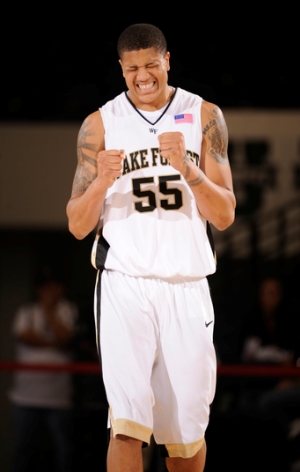
Tony Woods has not played a game of college basketball since he was a sophomore at Wake Forest. Considering the trajectory the career of the average young big man takes, we'll hold off on re-evaluating him until we have a legitimate sample to compare to our previous comprehensive reports.













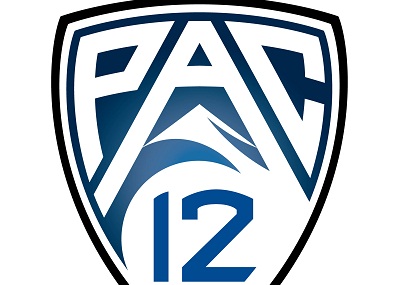

























Comments